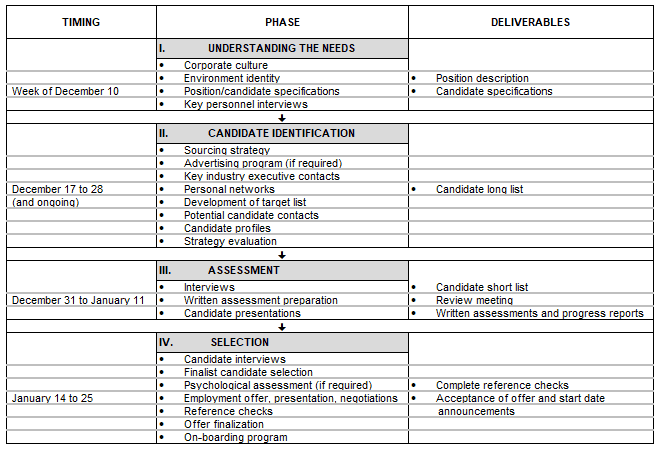Choosing a key person for your company is a big decision that should not be taken lightly. Many companies opt to do their recruiting internally by posting their openings on their websites or on job boards. This is easy enough to get started, but when the résumés start coming in, someone has to sort through them and decide which ones deserve further consideration. It has to be done in a timely manner because résumés are perishable. Just like fruit on display at the supermarket, in a few weeks they won’t be that useful, as many of the people behind those résumés will be gone (the best ones for sure).
Rather than leave the decision-making to a single individual, some companies will create an Executive Search Committee (at least for more senior positions). Finding  the right person for the job is a process that needs to be thought through and can take a lot of time. Depending on the role, this individual can have a huge impact on the company and so it is imperative that the RIGHT person be found. Hiring the wrong person can have lasting negative effects on your company, your other employees and your customers.
the right person for the job is a process that needs to be thought through and can take a lot of time. Depending on the role, this individual can have a huge impact on the company and so it is imperative that the RIGHT person be found. Hiring the wrong person can have lasting negative effects on your company, your other employees and your customers.
This is why it is important to take an organized approach to finding a key employee, and an Executive Search Committee can help to keep everything under control. There is a lot of complexity that goes into key person hiring, and having a committee to collaborate on the decision can minimize the risks.
Once the committee is in place, a formal executive search timeline needs to be set out to keep everything moving along smoothly. An executive search timeline can help to make sure that the process of hiring a key employee is efficient and has the right steps in place to find and secure the right person for the job. Properly setting up the Executive Search Committee and timeline is imperative to ensure the success of filling the role with the best talent possible.
Here are a few things to consider when setting up an executive search committee and timeline:
1. Build the Right Committee
 First, you want to ensure that your executive search committee has the right people on it and has the right decision-making hierarchy in place. Find the right people for the committee who will be impacted by the new hire, and also people who have unbiased and objective views on the type of candidate who would be a great fit. Make sure there are no conflicts of interest and that everyone on the committee has the time to commit to things such as development of the job responsibilities, candidate requirements, interviews and discussions. Remember, one person can really slow down the process, so ensure that everyone on the committee can commit to the time required.
First, you want to ensure that your executive search committee has the right people on it and has the right decision-making hierarchy in place. Find the right people for the committee who will be impacted by the new hire, and also people who have unbiased and objective views on the type of candidate who would be a great fit. Make sure there are no conflicts of interest and that everyone on the committee has the time to commit to things such as development of the job responsibilities, candidate requirements, interviews and discussions. Remember, one person can really slow down the process, so ensure that everyone on the committee can commit to the time required.
2. Agree on the Job and Candidate Details
 Now is your chance to define what the responsibilities of the job are. This is often an excellent opportunity to redefine other organizational roles as well so that the entire organization operates more efficiently as a result. Also, set out the “must have” and “nice to have” candidate requirements. Having this thoroughly considered and clearly established from the beginning will save a lot of time by avoiding distractions. Be sure to focus not only on skills and experience but also those factors which are necessary for the new person to make a good cultural fit with your organization.
Now is your chance to define what the responsibilities of the job are. This is often an excellent opportunity to redefine other organizational roles as well so that the entire organization operates more efficiently as a result. Also, set out the “must have” and “nice to have” candidate requirements. Having this thoroughly considered and clearly established from the beginning will save a lot of time by avoiding distractions. Be sure to focus not only on skills and experience but also those factors which are necessary for the new person to make a good cultural fit with your organization.
Read More: Hire the Best, Forget the Rest
3. Set the Rules and Process in Place
 Agree on the process for candidate evaluation. Will the entire executive search committee be involved in all interviews or will there be initial interviews by a smaller group? Will there be points systems with a number of weighted factors scored by each member of the committee for each candidate? Will detailed personality profiles be utilized and how will those results be considered along with other candidate information?
Agree on the process for candidate evaluation. Will the entire executive search committee be involved in all interviews or will there be initial interviews by a smaller group? Will there be points systems with a number of weighted factors scored by each member of the committee for each candidate? Will detailed personality profiles be utilized and how will those results be considered along with other candidate information?
4. Create an Executive Search Timeline
Create a timeline based on the following things: writing the position specification, screening candidates to select a short list, interviewing short list candidates, re-interviewing finalists, making the offer, performing reference checks and setting an onboarding program for the successful candidate.
Set out a target date for completion of each stage to keep everything on track.
Timeline Example:

5. Consider Using an Executive Search Firm
If you have a strong committee process and internal HR and recruiting in place, you may feel confident in doing all aspects of an executive search on your own.  However, executive search firms are experts at what they do, and they can take a lot of the stress off your plate while also helping the process move along efficiently. When you need to hire a key employee, chances are that time is of the essence. A search firm can help to ensure that things happen at a quicker pace than internal processes.
However, executive search firms are experts at what they do, and they can take a lot of the stress off your plate while also helping the process move along efficiently. When you need to hire a key employee, chances are that time is of the essence. A search firm can help to ensure that things happen at a quicker pace than internal processes.
An executive search firm is skilled in finding executives and other key employees and knows how to be competitive in looking for high potential candidates. Since search firms have an unbiased “outsider” lens, they can often find candidates that you would otherwise not come into contact with.
6. Have Tough Conversations
As mentioned earlier, finding the next star employee for your company is a serious undertaking. Whether you are looking for a middle manager or a senior executive, it is important to get it right. It takes time for an new employee to get up to speed in a company and if a mistake has been made, three or four months have probably gone  by before that is clearly confirmed, and the process of termination and reinitiating the search can be both time consuming and expensive.
by before that is clearly confirmed, and the process of termination and reinitiating the search can be both time consuming and expensive.
You can avoid hiring the wrong person by ensuring that the executive search committee acts in an organized and deliberate manner, asks tough questions and thoroughly debates both the details of the position to be filled and the evaluation of the short-listed candidates.
If there is strong dissent among the committee members, patience in continuing the dialogue will be rewarded with a better decision. Taking longer to get it right will save a lot of time and expense in the long run.
Read More: The Top 8 Common Recruiting Mistakes (And How to Avoid Them)
The Bottom Line
Conducting an executive search is serious business, and the company has to be equipped for the task. Leveraging an outside firm to handle the executive search is a great way to save stress, time, and money in the long run. Getting access to great talent by exploring the largest possible pool of candidates is what executive search firms do for a living. If your committee doesn’t feel confident in shouldering the whole process, then you should definitely consider bringing in the pros.
Kathbern Management is an executive search consultancy based in Toronto, helping companies find the executives and senior managers who not only have the experience and credentials to fulfil their responsibilities, but also have the emotional and “fit” requirements that will enable them to be successful in a particular environment. We simplify the process and, through our deep research, are able to bring more and better candidates forward than would ever be possible through a do-it-yourself passive advertising campaign.
Contact us today for a free consultation about your key person search.

